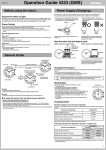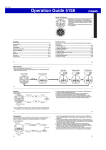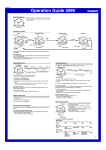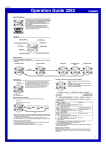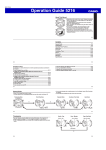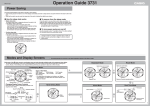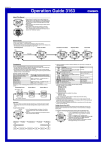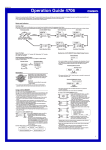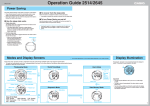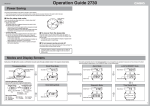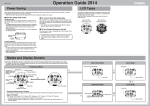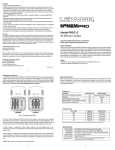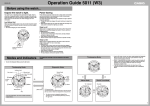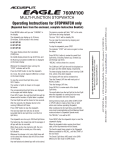Download Casio MA0811-EA 0811-EA User's Manual
Transcript
Operation Guide 5002 (GMS) MA0811-EA Before using the watch... Modes and Indicators Expose the watch to light. Power Saving Your watch runs on electrical power generated from light, which is stored by a chargeable battery. Long-term storage of the watch can cause power to run low, so be sure to expose the watch to light for some time before using it for the first time. See “Solar Charging” for more information. Power Saving causes the watch to enter a sleep state automatically and stop movement of the analog hands in order to save power whenever the watch is left in the dark. The watch will exit the sleep state if you expose it to light or perform any button operation. • Note that the watch also may enter the sleep state and stop if the solar panel is blocked from light by your sleeve. 3OLARCELL ,IGHT 4IMEKEEPING-ODE $AY (OUR -INUTE "UTTON 3ECOND $AYFOTHEWEEK How the sleep state works Sleep Level 1 Sleep Level 1 is triggered whenever the watch is left in the dark for about one hour any time between the hours of 10 p.m. and 6 a.m. • Second hand stopped • The hour, minute, day, and day of the week hands continue to operate normally. • Auto Receive is disabled. Sleep Level 2 Sleep Level 2 is triggered whenever the watch is left in the dark while in Sleep Level 1 for six or seven days. • The hour, minute, day, and day of the week hands stop at their current positions. • Auto Receive disabled • Digital timekeeping functions continue to operate normally. 4HEFIGURESONTHERIGHTWILLBE EITHER4YPE!OR4YPE"SHOWN NEARBYDEPENDINGONYOURWATCH MODEL!LLOFTHEILLUSTRATIONSIN THISMANUALSHOW4YPE! "UTTON 3TOPWATCH-ODE HOURTIMEHOURHAND Your watch runs on electrical power generated from light, which is stored by a chargeable battery. To ensure stable operation, make sure that the watch is exposed to light as much as possible. 93UCCESSFUL • Whenever you are not wearing the watch on your wrist, position it so the face (solar cell) is pointed in the direction of a source of bright light. Leave the watch under fluorescent lighting, near a window, etc. 3OLARCELL While the watch is exposed to light... ,IGHT 3OLARCELL ,IGHTCHARGES THEBATTERY -ANUAL2ECEIVE (OLDDOWNTHEBUTTONFORABOUTTWOSECONDS UNTILTHEDAYHANDMOVESTOTHEh2v2%!$9 POSITION4HISWILLSTARTSIGNALRECEPTION #HARGE 0OWERSUPPLIEDTOWATCH While the watch is not exposed to light... • When wearing the watch, try to keep your sleeve from blocking its face, where the solar cell is located. Charging efficiency is reduced significantly even if the face of the watch is covered only partially by your sleeve. Depending on the light source you are using, the case of the watch may become quite hot when charging. Take care to guard against burn injury after charging. Dead Battery 2ECHARGEABLE BATTERY 2ECHARGEABLE $ISCHARGE BATTERY 0OWERSUPPLIEDTOWATCH Your watch continues to operate even when it is not exposed to light. Leaving the watch in the dark can run down its battery and cause functions to become disabled. The following conditions apply when the battery is dead. • Timekeeping stops. • Auto receive and manual receive are disabled. • Second hand stops immediately at 12 o’clock. • Hour and minute hands stop at 12 o’clock at midnight. • Even if the battery level drops to the point that timekeeping stops, you still will be able to recharge the battery and use the watch again. • After you recharge the battery when it drops to a level where timekeeping stops, the hands will move automatically to the current time setting. • Try to keep the watch exposed to light as much as possible during normal use. 4HESTOPWATCHMEASURESELAPSEDTIMEINUNITSOF SECONDUPTOMINUTESSECONDSMINUTES 3TART3TOP 0RESSTHEBUTTONTOSTARTANDSTOPTIMING 2ESET 0RESSTHEBUTTONTORESETTHESTOPWATCHTOALLZEROS Charging Guide Avoid charging the watch in the following locations, and anywhere else where the watch may become very hot. • On the dashboard of an automobile parked in the sun • Very close to an incandescent light source or other sources of heat • In a location exposed to direct sunlight for long periods %LECTRICALENERGY ,IGHT 2ESET .5NSUCCESSFUL Charging Precautions How the solar cell and battery work 3TART3TOP 3TOPWATCH SECONDS 3TOPWATCH MINUTES 4OCHECKTHERECEPTIONRESULT 0RESSTHEBUTTON 4HEDAYHANDWILLMOVETOh9v SUCCESSFULORh.vUNSUCCESSFUL TOINDICATETHERECEPTIONRESULT 4YPE" 3TOPWATCH-ODE "UTTON &ORMOREINFORMATIONSEE h(OWA2ADIOCONTROLLED7ATCH7ORKSv Solar Charging 4YPE! Required Charging Time for One Day of Operation • The following values assume six minutes of calibration signal reception per day. %XPOSURE,EVEL"RIGHTNESS /UTDOOR3UNLIGHTLUX 3UNLIGHTTHROUGHA7INDOWLUX $AYLIGHTTHROUGHA7INDOWON AN/VERCAST$AYLUX )NDOOR&LUORESCENT,IGHTINGLUX #HARGING4IME MINUTES MINUTES MINUTES HOURS Making sure the watch is exposed to light ensures stable operation. $EAD"ATTERY (ANDSSTOPATOCLOCK Approximate Charge Times Required to Advance to a Higher Level %XPOSURE,EVEL "RIGHTNESS #HARGING4IME 5NTIL(AND 5NTIL&ULL#HARGE -OVEMENT2ESTARTS /UTDOOR3UNLIGHT LUX HOURS HOURS 3UNLIGHTTHROUGH A7INDOWLUX HOURS HOURS $AYLIGHTTHROUGH A7INDOWONAN /VERCAST$AYLUX HOURS HOURS )NDOOR&LUORESCENT ,IGHTINGLUX HOURS nnn • Note that the above charging times are for reference only. Actual charging time depends on a variety of environmental factors. 1 Operation Guide 5002 (GMS) How a Radio-controlled Watch Works Receiving a Calibration Signal At the start of the receive operation There are two methods you can use to receive the time calibration signal. • The day hand will move to “READY” (“R” for some models). • The hour and minute hands will remain at their normal positions. • The second hand will stop at “60”. What is a radio-controlled watch? Calibration Signal Auto receive While reception is in progress A radio-controlled watch is designed to receive a time calibration signal that contains standard time data and adjust its current time setting accordingly. • The Japanese calibration signal (Call Sign: JJY) is maintained by the National Institute of Information and Communications Technology (NICT). It is transmitted 24 hours a day from the Mt. Otakadoya transmitter (40 kHz) located in Tamura-gun, Fukushima Prefecture, and from the Mt. Hagane transmitter (60 kHz) located on the border between Saga Prefecture and Fukuoka Prefecture. • The U.S. calibration signal (Call Sign: WWVB) is transmitted by the National Institute of Standards and technology from Fort Collins, Colorado. Up to six times per day (Midnight, 1:00, 2:00, 3:00, 4:00, and 5:00 a.m.) • As soon as one auto receive is complete, all subsequent auto receives for that day are cancelled. • The day hand will move to “WORK” (“W” for some models). • The hour and minute hands will remain at their normal positions. • Do not move the watch while signal reception is in progress (second hand at “WORK”). 4RANSMITTER ,ONGWAVETIME CALIBRATIONSIGNAL 7ATCH #ESIUM ATOMICCLOCK After the watch receives the Standard Time signal, it performs internal calculations to determine the current time. Because of this, there may be an error of up to one second in the displayed time. • Time calibration signal frequencies and transmitter locations are subject to change. The time data of the Japanese calibration signal (Call Sign: JJY) is maintained by the Japan Standard Time Group of the National Institute of Information and Communications Technology (NICT). Note that transmission of the calibration signal may be interrupted occasionally due to maintenance, lightning, etc. For more information, visit the website of the Japan Standard Time Group of the National Institute of Information and Communications Technology (NICT) at the following URL. Manual Receive You initiate signal reception by pressing a button. In the Timekeeping Mode, hold down the B button for about two seconds. • The day hand will indicate the result of the reception, and then move to “READY” (“R” for some models). 7/2+OR7 .5NSUCCESSFUL 2%!$9OR2 ■ To cancel a manual receive operation http://jjy.nict.go.jp Press any button. • Note that the above URL is subject to change. ■ To check the result of the last receive operation In the Timekeeping Mode, press the B button. This will enter the last signal receive mode. The day hand will move to “Y” (if the last reception was successful) or “N” (if the last reception was unsuccessful). • Press the B button once to return to normal timekeeping. • The watch also will return to the Timekeeping Mode automatically if you do not perform any operation for about five seconds. ■ To position the watch for optimum reception Remove the watch from your wrist and place it somewhere so its top (12 o’clock side, where the antenna is located) is pointing approximately in the direction of the signal transmitter. Keep the watch away from metal objects. • Orienting the watch so it is sideways to the transmitter makes it more difficult for it to receive the signal. • Do not move the watch while it is receiving the calibration signal. Reception Ranges This watch is designed to receive the standard time calibration signal of Japan (JJY) or of the United States (WWVB). The signal that is received depends on the current Home City setting. • For information about selecting a Home City and city codes, see “To configure Home City settings”. (OME#ITY 3UPPORTSSIGNALRECEPTION 49/(+' ,!8$%.#().9# 2ESINBAND 93UCCESSFUL When reception is complete... • When the receive operation is successful, the day hand will move to “Y”, and then after about five seconds the watch will adjust its time and normal timekeeping will resume. • When the receive operation is unsuccessful, the day hand will move to “N”, and then after about five seconds the normal timekeeping will resume. 4RANSMITTER,OCATIONS KM KM 2ECEIVABLE4RANSMITTER *APAN**9 *APAN**9 -T(AGANE K(Z 5NITED3TATESTIMECALIBRATION SIGNAL776" • Signal reception also is possible in Hong Kong (HKG) when reception conditions are good. -T/TAKADOYA K(Z KM KM 5NITED3TATES776" 93UCCESSFUL KM .5NSUCCESSFUL -ETALBAND The last receive status changes each time a new time calibration signal reception operation is performed. KM &ORT#OLLINS Time Required for Reception Signal reception normally takes anywhere from about two to seven minutes. Under certain signal conditions however, the receive operation can take as long at 14 minutes. Certain conditions can make reception impossible even when the watch is within one of the reception ranges shown above. Signals become weaker outside of the smaller circles indicated by dashed lines in the nearby maps, so the reception environment has a greater effect on signal reception. • The following also can affect signal reception: geographic contours, structures, weather, climate, time of day (afternoon, evening), noise. 2 Operation Guide 5002 (GMS) Location Reception is difficult and may even be impossible in the locations described below. Avoid such locations when performing signal reception. • You should think of your watch as operating like a radio or TV when it is receiving the calibration signal. Among or near buildings Inside an automobile, train, plane, or other vehicle At a construction site, airport, or other location where there is radio interference Near high-voltage lines Next to a household appliance or office equipment (TV, speaker, fax, computer, cell phone, etc.) Troubleshooting Calibration Signal Reception Precautions • Auto Receive is not performed while the watch is in the Stopwatch Mode. • Pressing any button while auto receive is in progress will cause the watch to exit the receive operation. • Make sure you are within the range of a calibration signal transmitter before performing the receive operation. Remember that geographic contours, nearby buildings, the season, or the time of day can make reception impossible even when you are within range of the transmitter. • Proper reception may be impossible if there is something blocking the signal. If reception is unsuccessful, try again. • This watch is designed to adjust its current time setting in accordance with the calibration signal transmitted in Japan and the United States only. Note that you will need to make your own adjustments when using this watch outside of Japan or the United States, or in any area that is outside the range of one of the receivable time calibration signal transmitters. • When the watch is unable to adjust its time using the calibration signal for some reason, timekeeping accuracy is within ±20 seconds per month. • Strong electrostatic charge can cause timekeeping error. • The watch’s calendar shows dates up to the year 2099. Attempting a receive operation after that causes an error. 1. The watch cannot receive the time calibration signal. • Is there something in the immediate area that may be interfering with reception? Even if you are within the reception range of a transmitter, electrical noise or objects between you and the transmitter can interfere with reception. Avoid such areas during signal reception. See “Location” for more information. • Are you within the reception range of a transmitter? See “Reception Ranges” for information about areas where the watch can receive the signal. • Do you have the correct Home City code selected? For details about setting the correct Home City, see “To configure Home City settings”. • Is the signal being transmitted? Transmission of time calibration signals may be interrupted occasionally due to maintenance, lightning, etc. 2. Time calibration signal reception is successful, but the hourly time signal and current time are slightly off. • After the watch receives the time calibration signal, it performs an internal decoding process before updating its time setting. Because of this, the time setting may be off slightly (within one second). 3. Time calibration signal reception is successful, but the current time setting is wrong. • Is your Home City setting correct? See “To configure Home City settings” for more information. • If you cannot receive the calibration signal or if the time setting is incorrect after signal reception, check the setup of the watch. • The following are the watch’s factory default settings, which are configured automatically whenever you have the battery of the watch replaced. (OME#ITY 49/4OKYO 3UMMERTIME !4ACCORDINGTOSIGNALDATA Near mountains If you are experiencing problems with reception, move away from the types of locations described above to a location with better reception, and try again. Stopwatch The stopwatch measures elapsed time in units of 1 second up to 59 minutes, 59 seconds (60 minutes). When the maximum limit is reached, the elapsed time returns to zero automatically and timing continues from there. ■ To start or stop an elapsed time operation Perform the operations below in the Stopwatch Mode. 3ECONDS • To enter the Stopwatch Mode, press the C button while in the Timekeeping Mode. 4IMEKEEPING-ODE 3TART3TOP 3TOPWATCH-ODE -OVESTOOCLOCK -INUTES 2ESET 3TART #OUNTSSECONDS -OVESTO 3TOP 2ESET • Pressing C while elapsed time measurement is in progress will reset to all zeros. Cumulative Elapsed Time Measurement • Press the B button to return to the Timekeeping Mode. Pressing the A button to restart the stopwatch without resetting it to all zeros will resume elapsed time measurement from where it was last stopped. • Note that leaving the stopwatch running will run down the battery. 3 Operation Guide 5002 (GMS) 3. Configuring Home City Settings You can use the following procedure to set the current time and date of the Home City that you have selected in the Timekeeping Mode. • Always use the Timekeeping Mode to set and adjust the current time and date settings. 2. You also can use the procedures in this section to adjust the time and date when the watch is unable to receive a time calibration signal for some reason. In the Timekeeping Mode, keep B depressed (for about five seconds) as the day, right dial, and left dial hands perform the sequence described below. • The day hand moves to the last signal reception result to “R”, and then to the currently selected city code. • The right dial hand moves to “T.Z” (time zone). • The left dial hand moves to “AT”, “ON”, or “OFF”. • This is the setting mode. $AYHAND 2IGHTDIAL HAND ,EFTDIAL HAND 4YPE"RIGHTDIALHAND )NDICATES THEDAYOF THEWEEK $AYHAND INDICATESCITYCODE • See the table below for details about city code positions. • For some models, city codes are not marked on the dial. • For some models, city codes are marked on the back cover of the watch. ■ To configure Home City settings 1. To change the Home City setting, press C to move the day hand between the city code positions on the dial. $AY(AND 0OSITION SECONDS SECONDS SECONDS SECONDS SECONDS SECONDS To change the summer time setting, press the A button to move the left dial hand between the three available settings described below. 4. Press B to advance to day and day of the week setting. $AYHAND • The day hand and right dial hand will move to their current settings. )NDICATES SUMMERTIMESETTING 2IGHTDIALHAND AT (AUTO) #ITY 54# #ODE /FFSET 49/ 4OKYO (ONG+ONG (+' n ,OS!NGELES ,!8 $%. n $ENVER #() n #HICAGO n .9# .EW9ORK #ITY.AME • The contents of the above table are current as of March 2008. • Time offsets for this watch are in accordance with Universal Time Coordinated (UTC). This setting enables the auto summer time setting, which turns summer time on or off in accordance with the received time calibration signal. 5. Press C (+) to change the day setting. $AYOFTHE WEEK ON This setting turns on summer time, which advances the time setting by one hour. OFF 6. Press A (+) to change the day of the week setting. This setting turns off summer time, and displays the current time normally. $ATE Summer time, or Daylight Saving Time (DST) as is it is called in some countries, calls for setting clocks ahead one hour during the summer season. Note that the use of summer time depends on the country and even the local area. • If you only want to change the Home City and summer time settings, go directly to step 9 of this procedure. 7. $AYHAND Press B to advance to current time setting. • The right dial hand will move to “SET” and the day hand will move to “A” (a.m.) or “P” (p.m.) 2IGHTDIALHAND 4YPE"RIGHTDIALHAND )NDICATES THEDAYOF THEWEEK 8. Press the C button to change the time setting. Each press of C moves the setting clockwise by one minute. • Holding down the C button will cause the time setting to move at high speed. To stop high-speed hand movement, press any button. • When setting the time, make sure that you set it so the day hand (a.m./p.m.) and 24-hour hand are in the correct positions. (OURHAND -INUTEHAND !AM 9. When all of the settings are the way you want, press B. This will exit the setting mode and the left dial hand will resume normal operation. • If you change the Home City and/or summer time setting, normal left dial hand operation will resume after the hour and minute hands move to their new positions based on your setting. • If you change the current time setting, normal left dial hand operation will resume from 00. • If you did not change the current time setting, normal left dial hand operation will resume from the location it was at when you started the setting procedure above. • The watch will exit the setting screen automatically if you do not perform any button operation for about two or three minutes. When you are using the watch in an area that supports time calibration signal reception, it will adjust the date automatically for month lengths and leap years. If you use it in an area that does not support signal reception, you will have to make adjustments for month lengths and leap year manually. HOURHAND 0PM 4 Operation Guide 5002 (GMS) 3. Home Position Adjustment If the time setting of your watch is not correct even though time calibration signal reception is being performed normally, use the procedure in this section to check the home positions of the hands and make adjustments as required. Note that you do not need to perform the following operation if your watch is showing the correct time. 1. In the Timekeeping Mode, hold down the A button and then the B button, keeping both buttons depressed for about five seconds until the day hand and left dial hand move to their home positions. 2. $AYHAND ,EFTDIAL HAND (OURANDMINUTEHANDS • This should cause all three hands to move to their home positions. If the left dial hand position is off, use C to move it clockwise to correct it. • Holding down the C button will cause the left dial hand to move at high speed. • High-speed movement of the left dial hand will continue until it completes a full revolution, or until you press any button to stop it. Press B to advance to home position adjustment for the hour, minute, and lower dial hands. Home Positions Hour hand: 12 o’clock Minute hand: 12 o’clock Lower dial hand: 24 o’clock ,OWERDIALHAND • If the hour, minute, and lower dial hands are all at their proper home positions, advance to step 5. 4. If the hour and minute hand positions are off, use C to move them clockwise to correct them. • Holding down the C button will cause the hands to move at high speed. • High-speed movement will continue until it completes a 24-hour cycle, or until you press any button to stop it. • The 24-hour time hour setting of the lower dial hand is synchronized with the hour and minute hands, so separate adjustment is not required. Home Positions Day hand: 31 Left dial hand: 60 • If the hands are at their proper home positions, advance to step 3. 5. Press the B button to advance to home position adjustment of the day and right dial hands. 2IGHT DIALHAND • This should cause the day and right dial hands to move to their home positions. 7. Home Positions Day hand: 31 Right dial hand: ▼ (between SU and MO) 6. $AYHAND 4YPE"RIGHTDIALHAND )NDICATES THEDAYOF THEWEEK • If the day of the day and right dial hands are at their proper home positions, advance to step 8. If the day hand position is off, use C to move it clockwise to correct it. $AYOFTHE WEEK To exit home position adjustment and return to normal timekeeping, press B. • The watch also will exit home position adjustment automatically if you do not perform any operation for about two or three minutes. If the right dial hand position is off, use A to move it clockwise to correct it. • Holding down the C or A button will cause the hand to move at high speed. • High-speed movement of the will continue until the hand completes a full revolution, or until you press any button to stop it. 8. $ATE After completing the home position adjustment procedure, put the watch in a location where it is able to receive the time calibration signal easily and perform a manual receive operation. • For information about the manual receive operation, see “Receiving a Calibration Signal”. 5





